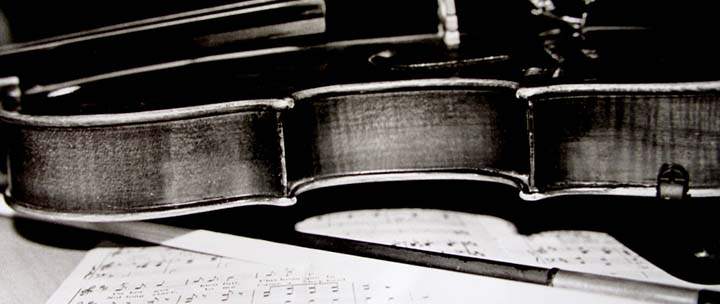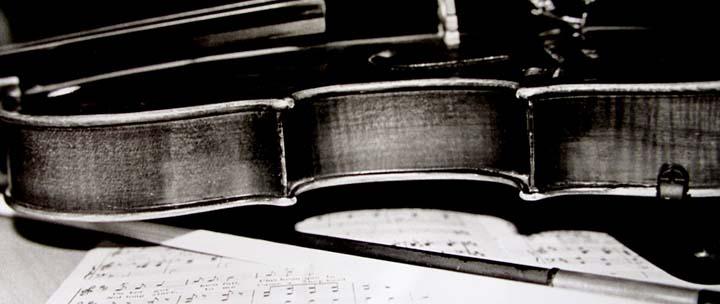 Playing some familiar tunes is one of the first things you may pursue when learning a new instrument. You might start the violin thinking it will be years before you can play the music you want, but you’ll be pleasantly surprised to learn that many familiar favorites are available as easy violin music.
Playing some familiar tunes is one of the first things you may pursue when learning a new instrument. You might start the violin thinking it will be years before you can play the music you want, but you’ll be pleasantly surprised to learn that many familiar favorites are available as easy violin music.
Simplified sheet music makes it easier than ever to move from bland scales and exercises to pieces you actually recognize. Add these pieces to your repertoire early on and you’ll return to them again and again as you continue to improve.
“German Dance” by Karl Ditters von Dittersdorf
Karl Ditters was an Austrian composer who lived from 1739 to 1799. During that time, he wrote more than 120 symphonies, 45 operas, and many other works. The violin was Ditters’ instrument of choice and the one that made him most famous in his day. “German Dance” is perhaps his best-known work. Even the full orchestral piece is not lengthy or pretentious, proving that music doesn’t require these qualities in order to earn longevity.
“Humoresque” by Antonín Dvorák
The Humoresques were written by Czech composer Antonín Dvorák in 1894. The most famous of these is “Humoresque #7”. Though originally written for piano, the piece clearly shines when played on the violin as well. Dvorák, an accomplished violinist and violist, lived in America from 1892 to 1895, during which time he collected many interesting and new themes in his notebooks. He used these ideas to compose the Humoresques.
“Gymnopédies #1” by Erik Satie
Erik Satie, a French composer who lived from 1866 to 1925, wrote three Gymnopédies, collectively regarded as a major precursor to modern ambient music. The pieces are gentle yet somewhat eccentric. Each one is written in 3/4 time and shares a common theme and structure.
When Satie composed the three Gymnopédies, they defied tradition at that time. Deliberate, mild dissonances produce a melancholy effect throughout each piece. If you look closely at the sheet music, it may tell you to play Gymnopédies “sadly” or “gravely.” The song was originally written for piano, but it translates well to violin.
“Jesu, Joy of Man’s Desiring” by Johann Sebastian Bach
Johann Sebastian Bach wrote this well-known Baroque piece between 1716 and 1723. You might recognize it from a recent wedding you went to or from modern covers by well-known singers such as Josh Groban and Sarah Brightman. You can hear “Jesu, Joy of Man’s Desiring” played instrumentally or with lyrics written by Robert Bridges, which are the most commonly words used when the song is sung in English.
Mastering this Bach piece for violin creates an excellent opportunity to be accompanied by a piano. Together, the two instruments really flesh out the piece.
“Pomp and Circumstance” by Sir Edward Elgar
The complete set of marches written by Sir Edward Elgar are called the “Pomp and Circumstance Military Marches, Op. 39”. These were written over a three-decade period spanning 1901 to 1930. The song linked here, which you probably recognize from graduation processionals, is simply called Pomp and Circumstance, or March No. 1 in D. The name comes from Act III, Scene 3 of “Othello” by Shakespeare, where he writes, “Pride, pomp, and circumstance of glorious war!”
This piece is traditionally played by a full orchestra, though the melody can be carried by violin alone. It’s excellent easy violin music to learn as a beginning violinist.
“Hungarian Dance No. 5” by Johannes Brahms
Johannes Brahms wrote 21 lively dance tunes, the most famous of which is “Hungarian Dance No. 5”. Almost all of these dances are based on Hungarian themes and range in length from one to four minutes. The well-known “Hungarian Dance No. 5” was based on the csárdás by Béla Kéler titled “Bártfai emlék.” Brahms mistook it for a traditional folksong.
Regardless of its origins, “Hungarian Dance No. 5” has remained popular since it was composed in 1869. The link here showcases a more advanced recording of the piece, though versions arranged for easy violin music are also available.
“Air on the G-String” by Johann Sebastian Bach, arranged by August Wilhelmj
This piece is a specific arrangement of “Orchestral Suite No. 3 in D major” by Johann Sebastian Bach. He originally wrote the suite between 1717 and 1723. In 1871, German violinist August Wilhelmj arranged the second movement of the orchestral suite for violin and piano. The name comes from the fact that, when Wilhelmj changed the key to C major and transposed the melody down an octave, he could play the entire piece on just the G string of his violin.
“Eine Kleine Nachtmusik, First Movement” by Wolfgang Amadeus Mozart
Wolfgang Amadeus Mozart composed this well-known chamber ensemble piece in 1787. In English, the German title literally means “a little night music,” but a more accurate translation is “a little serenade.” Rather than actually giving the composition this endearing name, it’s most likely that Mozart was simply making a note in his records that he had completed his little serenade. After all, the work was not published until 1827, long after Mozart’s death in 1791, and that was the only name the publishers had to go by.
When you listen to the performance in the link provided, you may notice the piece is a little more complex than the other easy violin music selections listed here. Once you’ve mastered these other pieces, though, you’re ready to give this one a try, especially if you slow down the tempo when first learning it.
With so much easy violin music to draw from, it’s time to select a few favorites and start learning. Good luck!
Photo by leora.page
Suzy S.

